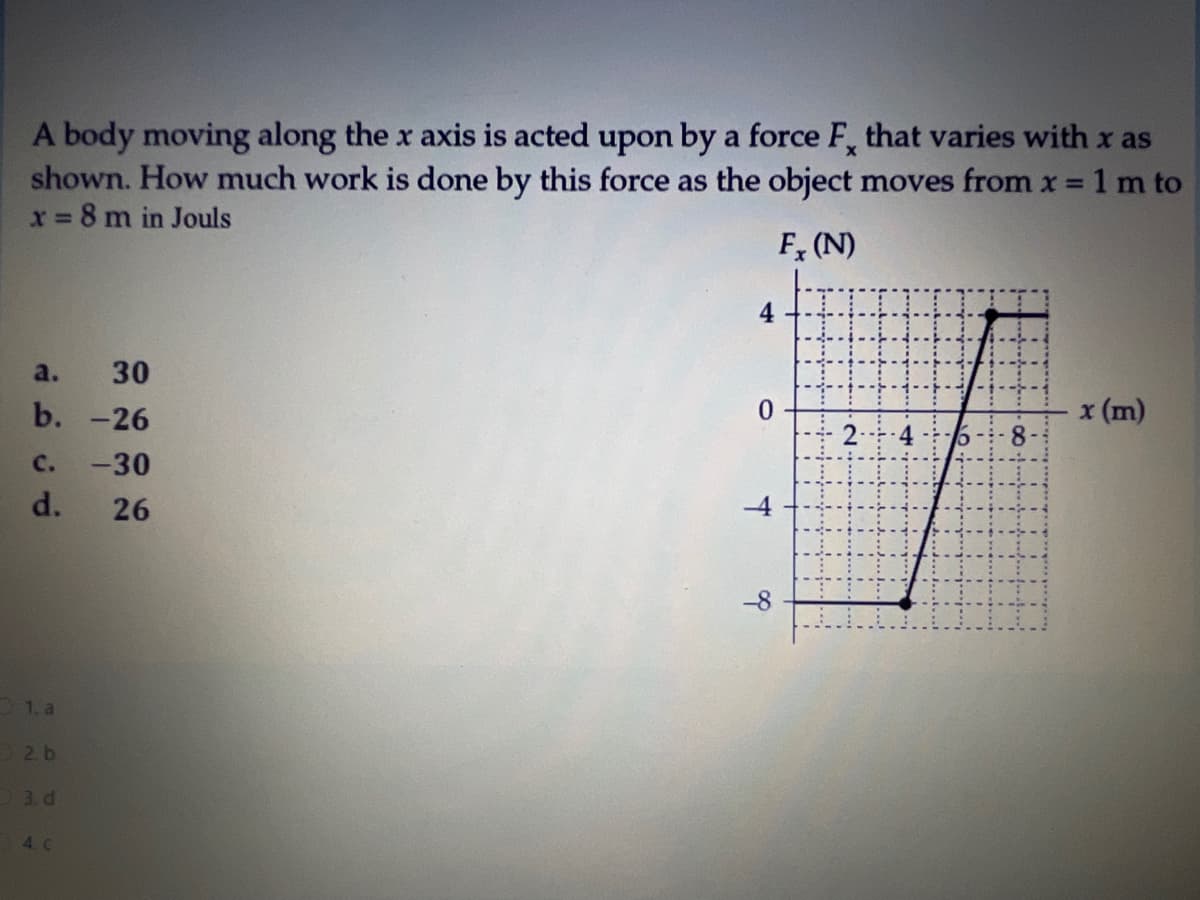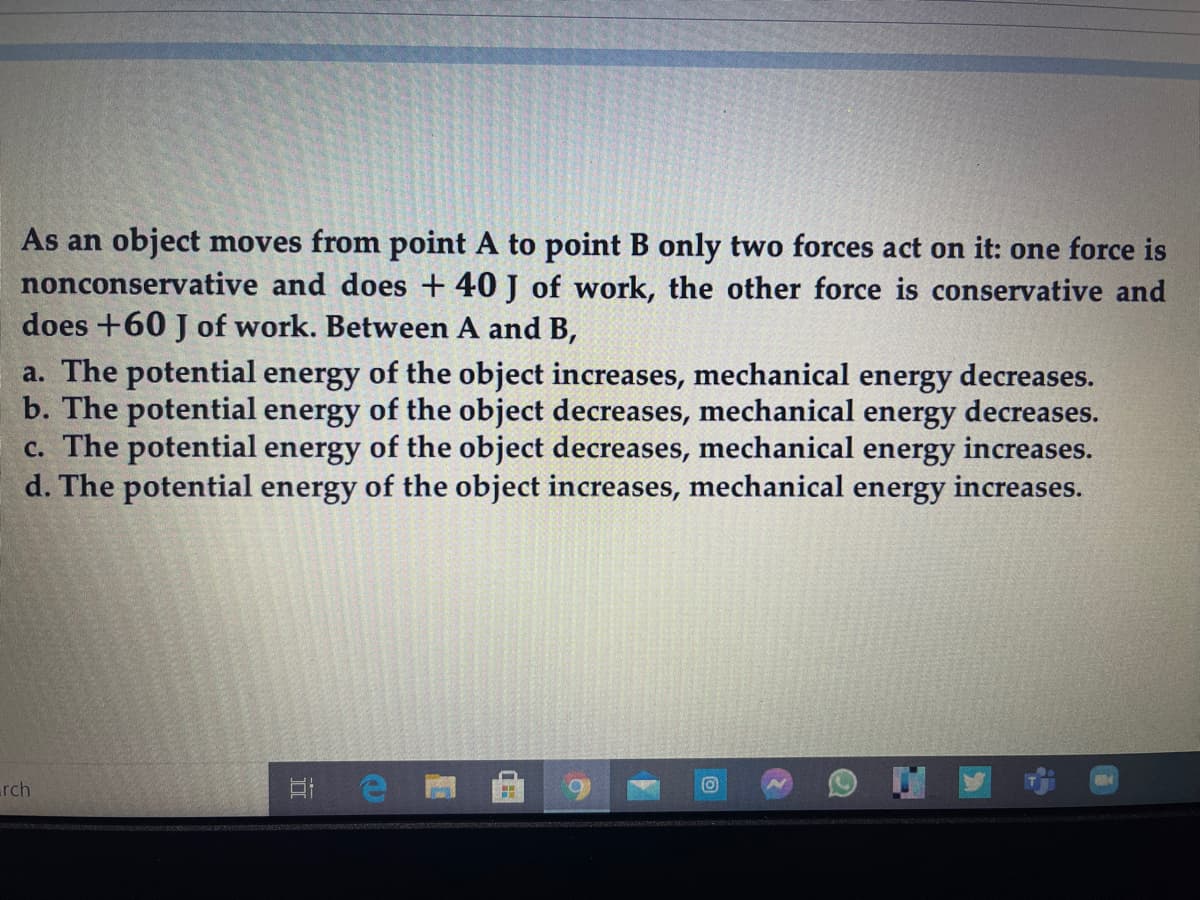A body moving along the x axis is acted upon by a force F, that varies with x as shown. How much work is done by this force as the object moves from x = x = 8 m in Jouls 1 m to F, (N) 4 a. 30 b. -26 0. x (m) с. -30 d. 26 -8 4.
A body moving along the x axis is acted upon by a force F, that varies with x as shown. How much work is done by this force as the object moves from x = x = 8 m in Jouls 1 m to F, (N) 4 a. 30 b. -26 0. x (m) с. -30 d. 26 -8 4.
Physics for Scientists and Engineers, Technology Update (No access codes included)
9th Edition
ISBN:9781305116399
Author:Raymond A. Serway, John W. Jewett
Publisher:Raymond A. Serway, John W. Jewett
Chapter7: Energy Of A System
Section: Chapter Questions
Problem 7.14P: The force acting on a panicle varies as shown in Figure la P7.14. Find the work done by the force on...
Related questions
Topic Video
Question

Transcribed Image Text:A body moving along the x axis is acted upon by a force F, that varies with x as
shown. How much work is done by this force as the object moves from x =
x 8 m in Jouls
1 m to
F, (N)
4
a.
30
b. -26
x (m)
2
с.
-30
d.
26
1. a
2 b
3. d
4. C
4.

Transcribed Image Text:As an object moves from point A to point B only two forces act on it: one force is
nonconservative and does + 40 J of work, the other force is conservative and
does +60 J of work. Between A and B,
a. The potential energy of the object increases, mechanical energy decreases.
b. The potential energy of the object decreases, mechanical energy decreases.
c. The potential energy of the object decreases, mechanical energy increases.
d. The potential energy of the object increases, mechanical energy increases.
rch
立
Expert Solution
This question has been solved!
Explore an expertly crafted, step-by-step solution for a thorough understanding of key concepts.
This is a popular solution!
Trending now
This is a popular solution!
Step by step
Solved in 3 steps with 2 images

Knowledge Booster
Learn more about
Need a deep-dive on the concept behind this application? Look no further. Learn more about this topic, physics and related others by exploring similar questions and additional content below.Recommended textbooks for you

Physics for Scientists and Engineers, Technology …
Physics
ISBN:
9781305116399
Author:
Raymond A. Serway, John W. Jewett
Publisher:
Cengage Learning

Principles of Physics: A Calculus-Based Text
Physics
ISBN:
9781133104261
Author:
Raymond A. Serway, John W. Jewett
Publisher:
Cengage Learning

Physics for Scientists and Engineers with Modern …
Physics
ISBN:
9781337553292
Author:
Raymond A. Serway, John W. Jewett
Publisher:
Cengage Learning

Physics for Scientists and Engineers, Technology …
Physics
ISBN:
9781305116399
Author:
Raymond A. Serway, John W. Jewett
Publisher:
Cengage Learning

Principles of Physics: A Calculus-Based Text
Physics
ISBN:
9781133104261
Author:
Raymond A. Serway, John W. Jewett
Publisher:
Cengage Learning

Physics for Scientists and Engineers with Modern …
Physics
ISBN:
9781337553292
Author:
Raymond A. Serway, John W. Jewett
Publisher:
Cengage Learning

Physics for Scientists and Engineers: Foundations…
Physics
ISBN:
9781133939146
Author:
Katz, Debora M.
Publisher:
Cengage Learning

College Physics
Physics
ISBN:
9781938168000
Author:
Paul Peter Urone, Roger Hinrichs
Publisher:
OpenStax College

Glencoe Physics: Principles and Problems, Student…
Physics
ISBN:
9780078807213
Author:
Paul W. Zitzewitz
Publisher:
Glencoe/McGraw-Hill